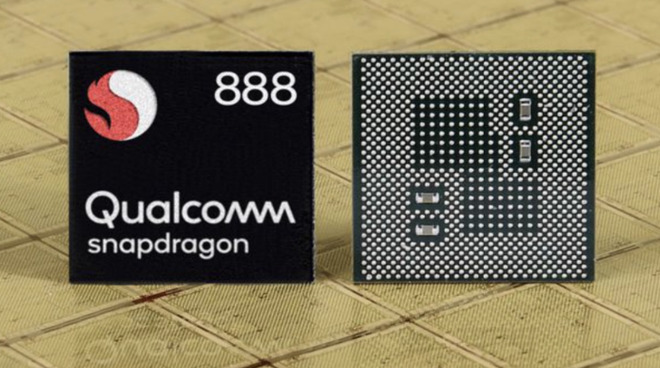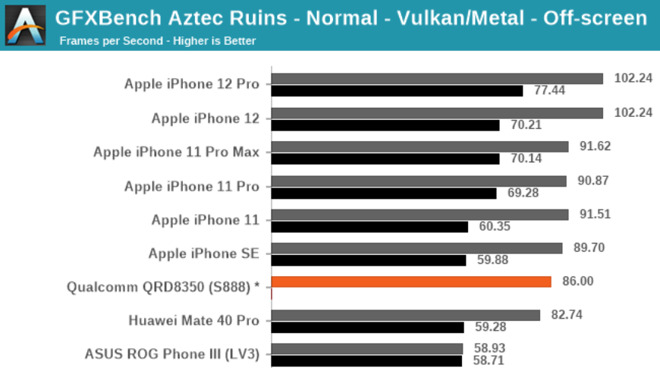Android 2021 flagship Qualcomm 888 processor isn't as fast as the iPhone 12
Qualcomm has provided benchmarks for its Snapdragon 888 flagship system on a chip, and they show lackluster performance versus the iPhone 12, and even lose out to older iPhones running the A13.

Qualcomm Snapdragon 888 benchmarked
Qualcomm announces its new processors every year in mid-December to preempt their arrival in products at CES. In 2020, the announcements were made online, and benchmarks were provided by the company.
The Snapdragon 888 performed well when compared to the current lineup of Android devices like the Samsung Galaxy Note 20 Ultra, but failed to surpass Apple's latest iPhones. Even the year-ago iPhone 11 lineup and iPhone SE running the A13 processor outperformed the new Qualcomm processor.
Qualcomm are using some powerful new technologies in its Snapdragon 888 making it a very competitive processor. It uses the Cortex-X1 as part of a similar big-little design that the A14 implements. The new SoC also includes the Adreno 660 GPU which is expected to perform 35% better than previous GPUs.
Anandtech received the benchmarks from Qualcomm and compared them to the known scores of other products. First is Geekbench 5, the well known CPU benchmarking tool that provides scores for single-core and multi-core operation.

Geekbench 5 CPU benchmark results Image Credit: AnandTech
The single-core score increased year-over-year by about 23.5% from 919 to 1135, which comes shy of the iPhone 11 Pro running the A13 which scored a 1,331. The multi-core score improved by 16.9% to achieve a score of 3,794 which overtakes the A13 processor's score of 3,366 but doesn't come close to the A14's 4,187 score.
The GPU benchmark shows even less promising results. Using GFXBench results, Anandtech laid out the graphics scores for various products vs the new Snapdragon 888.

GFXBench graphics benchmark results Image Credit: AnandTech
The scores are reported in peak frames per second, and the Snapdragon 888 handily beat all of the current Android flagships by as much as 55%. This could be an anomaly, but it is what was reported by Qualcomm, who previously suggested the graphics improvements would be around 35%.
When compared to the iPhone 12 and the iPhone 11 lineup, it didn't fare so well. It can be assumed that since these are peak results during the test that the Snapdragon may perform differently under extended load, but those tests will have to wait until reviewers get their hands on devices running the processor.
Qualcomm released other results like AI performance tests, but those are not comparable to the iPhone processors. Apple does have powerful neural engines in its A-series chips, not to mention its M1 processor, but those have not been properly benchmarked for comparison.

Qualcomm Snapdragon 888 benchmarked
Qualcomm announces its new processors every year in mid-December to preempt their arrival in products at CES. In 2020, the announcements were made online, and benchmarks were provided by the company.
The Snapdragon 888 performed well when compared to the current lineup of Android devices like the Samsung Galaxy Note 20 Ultra, but failed to surpass Apple's latest iPhones. Even the year-ago iPhone 11 lineup and iPhone SE running the A13 processor outperformed the new Qualcomm processor.
Qualcomm are using some powerful new technologies in its Snapdragon 888 making it a very competitive processor. It uses the Cortex-X1 as part of a similar big-little design that the A14 implements. The new SoC also includes the Adreno 660 GPU which is expected to perform 35% better than previous GPUs.
Anandtech received the benchmarks from Qualcomm and compared them to the known scores of other products. First is Geekbench 5, the well known CPU benchmarking tool that provides scores for single-core and multi-core operation.

Geekbench 5 CPU benchmark results Image Credit: AnandTech
The single-core score increased year-over-year by about 23.5% from 919 to 1135, which comes shy of the iPhone 11 Pro running the A13 which scored a 1,331. The multi-core score improved by 16.9% to achieve a score of 3,794 which overtakes the A13 processor's score of 3,366 but doesn't come close to the A14's 4,187 score.
The GPU benchmark shows even less promising results. Using GFXBench results, Anandtech laid out the graphics scores for various products vs the new Snapdragon 888.

GFXBench graphics benchmark results Image Credit: AnandTech
The scores are reported in peak frames per second, and the Snapdragon 888 handily beat all of the current Android flagships by as much as 55%. This could be an anomaly, but it is what was reported by Qualcomm, who previously suggested the graphics improvements would be around 35%.
When compared to the iPhone 12 and the iPhone 11 lineup, it didn't fare so well. It can be assumed that since these are peak results during the test that the Snapdragon may perform differently under extended load, but those tests will have to wait until reviewers get their hands on devices running the processor.
Qualcomm released other results like AI performance tests, but those are not comparable to the iPhone processors. Apple does have powerful neural engines in its A-series chips, not to mention its M1 processor, but those have not been properly benchmarked for comparison.

Comments
Here's a comparison of the 7nm Lightning cores in the A13 to a variety of competitors including the 5nm Cortex-X1: https://www.anandtech.com/show/15875/apple-lays-out-plans-to-transition-macs-from-x86-to-apple-socs.
Note that the Lightning cores beat the Cortex-X1 in all areas but floating point, and there are two Lightning cores in the A13 Bionic (used in the iPhone 11).
Since then, Apple has shrunk the Firestorm high performance cores in the A14 down to 5nm and improved the speed by an additional 20% and there are two of them in the A14 Bionic. There are four Firestorm cores in the M1 which are even faster, being clocked at 3.2 ghz, so the fastest single core in the 888 trails well behind the Firestorm cores in either the A14 or M1.
I’m happy they’re there to power a wide range of devices, since Apple obviously only focuses on its own product range.
Every leading chipmaker is already doing something. Qualcomm is actually sticking its third generation X60 modem onto that SoC.
Apple not only hasn't been able to produce a 5G modem, and much less get it on SoC, but is stuck using Qualcomm's second generation X55.
I've mentioned this many times before. A SoC is more than its GPU and CPU and Apple has been behind in some areas of chip components. I wouldn't go as far as calling that embarrassing but it is a fact.
It's why speed (and I'm not referring to benchmarking here) literally hasn't been an issue on flagships for years.
Although perhaps there is some irony in seeing those same Android phones outpace iPhones in some common tasks.
The 888 is using the same cutting edge process node as Apple, and if you look past pure CPU/GPU metrics it does offer some major upgrades.
Of course, Apple not being able to get a modern 5G modem on to the SoC has had a very clear knock-on effect. Battery life. It is very probably why Apple hasn't been able to put a 'flagship screen refresh rate' on its latest phones.
Personally, I don't give a hoot about refresh rates but at the top end, and along with photography, it is a tent pole feature and many clearly think that that is embarrassing for Apple.
I suggest you take a look at the rest of the 888. For example the ISP/DSPs, the X60 etc. Then you will see they, Huawei, Mediatek and Samsung have actually done a lot.
Apple of course has also done a lot but the point is ALL current flagship chips have done something and are far from embarrassing.
While I understand it's going on what's been provided, the Snapdragon 888 likely has a more powerful GPU in sustained performance (claimed and historical implementations demonstrate this).
Note - the higher end Snapdragon 865/+ based devices have typically offered the same peak and sustained performance. Meanwhile, the A13 and especially the A14 can be a bit of a mess despite that impressive peak performance.
The 888 also has a better integrated 5G modem and an extremely impressive ISP. In terms of AI? The 888's DSP (+CPU/GPU) offers 26 TOPS, the A14 only offers 11 TOPS.
It looks like Qualcomm will have to continue to rely on ARM's Cortex X program if they want to catch up (or at least try) to Apple in raw CPU performance. The underclocked Cortex X1 is an impressive jump, but not exactly ARM's ideal implementation (larger L2 and higher clock). Even in the ideal case, it would still fall short of Apple.
Remember when Samsung had that ad comparing their knockoff iPhone to an iPhone 6?!!! LOL
Competing with Apple isn't just about making a CPU that's as fast, it's actually making a CPU as fast, but cheaper to make.
And the same applies to Laptop/Destkop CPU, the M1 isn't a CPU that's cost efficient to make, Apple did things that would make other cpu makers go bankrupt if they ever tried to copy them. That's the perks of vertical integration.
You are correct in that one ultimately needs to look at the entire package, not just processor benchmarks, though.
Strategically Apple made some huge mistakes but they have their roots in a period of time from years ago.
For the 5G modem situation, Apple actually had options but they probably weren't worth taking. For example, producing a new SoC with the X60 on it. That would have meant a delay in releasing its absolute top end phone and cost a lot. Or they could have delayed releasing that phone and shipped the X60 off SoC. Again, cost would probably be an issue and although we will probably never know, I firmly believe that QC was in the driving seat when it came to negotiations to cease the court cases. The X60 might never have been on the table for Apple until late 2021.
From a consumer perspective, most consumers don't know or care who makes the chip (Let's be honest - most consumers don't even know what 5G means!) They just look for '5G.' From that standpoint, Apple is fine with the x55. The biggest issue is issues like power consumption which, as you said, means they may have to make compromises in other areas.
Regarding Apple's tryst with Intel, while it was a mistake, I think there were some positives that came out of it, so in the end, it may be hard to say whether they would have been better off staying with QC the whole time or not.